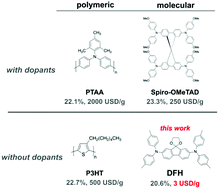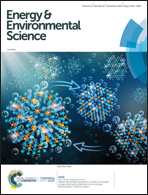Dopant-free molecular hole transport material that mediates a 20% power conversion efficiency in a perovskite solar cell†
Abstract
Organic molecular hole-transport materials (HTMs) are appealing for the scalable manufacture of perovskite solar cells (PSCs) because they are easier to reproducibly prepare in high purity than polymeric and inorganic HTMs. There is also a need to construct PSCs without dopants and additives to avoid formidable engineering and stability issues. We report here a power conversion efficiency (PCE) of 20.6% with a molecular HTM in an inverted (p–i–n) PSC without any dopants or interlayers. This new benchmark was made possible by the discovery that, upon annealing, a spiro-based dopant-free HTM (denoted DFH) containing redox-active triphenyl amine (TPA) units undergoes preferential molecular organization normal to the substrate. This structural order, governed by the strong intermolecular interactions of the DFH dioxane groups, affords high intrinsic hole mobility (1 × 10−3 cm2 V−1 s−1). Annealing films of DFH also enables the growth of large perovskite grains (up to 2 μm) that minimize charge recombination in the PSC. DFH can also be isolated at a fraction of the cost of any other organic HTM.



 Please wait while we load your content...
Please wait while we load your content...